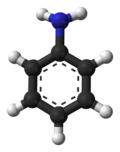Phenyl(trichloromethyl)mercury is an organomercury compound with the formula C6H5HgCCl3. It is a white solid that is soluble in organic solvents. The compound...
4 KB (320 words) - 22:19, 4 February 2025
Organomercury chemistry (redirect from Carbon-mercury bond)
Phenylmercuric chloride reversibly stores dichlorocarbene as phenyl(trichloromethyl)mercury. A convenient carbene source is sodium trichloroacetate: C6H5HgCl +...
16 KB (1,744 words) - 22:56, 6 July 2025
trichloroacetate. Upon treatment with sodium methoxide it releases CCl2. Phenyl(trichloromethyl)mercury decomposes thermally to release CCl2. PhHgCCl3 → CCl2 + PhHgCl...
9 KB (811 words) - 10:05, 24 June 2025
withdrawing nature of dihalocarbenes. Both phenyl(trichloromethyl)mercury and phenyl(tribromomethyl)mercury are sources dichlorocarbenes and dibromocarbenes...
65 KB (6,458 words) - 13:19, 24 June 2025
Such processes occur via enols and require the presence of an acid and mercury(II) sulfate (HgSO4). Subsequent enol–keto tautomerization gives a ketone...
24 KB (2,895 words) - 05:49, 12 July 2025
the Latin mercurio captāns ('capturing mercury') because the thiolate group (RS−) bonds very strongly with mercury compounds. There are several ways to...
36 KB (4,012 words) - 14:59, 10 July 2025
Zinc metal abstracts halogens similarly in the Simmons–Smith reaction. Mercuric and organomercury halides (except fluorides) can stably store a wide variety...
25 KB (2,597 words) - 05:10, 28 July 2025
O {\displaystyle {\ce {R2NH + R'(R''CH2)C=O -> R''CH=C(NR2)R' + H2O}}} Mercuric ions reversibly oxidize tertiary amines with an α hydrogen to iminium ions:...
38 KB (3,898 words) - 20:10, 16 July 2025
Polonium Polonol Polonoether Halo Haloalkane Fluoroethyl Trifluoromethyl Trichloromethyl Trifluoromethoxy Hypervalent iodine Vinyl halide Iodide Acyl halide...
35 KB (3,738 words) - 16:10, 13 July 2025
Addition of hydrogen halides has long been of interest. In the presence of mercuric chloride as a catalyst, acetylene and hydrogen chloride react to give vinyl...
24 KB (3,193 words) - 03:32, 16 June 2025
dihydroimidazol-2-ylidene were produced by vacuum pyrolysis of the corresponding 2-trichloromethyl dihydroimidazole compounds with the loss of chloroform. They conjectured...
58 KB (5,759 words) - 09:23, 21 July 2025
addition of sulfur to the nitrogen atom, especially in the presence of a mercury(II) sulfate catalyst. In contrast to the sluggish nitrations and sulfonations...
77 KB (7,720 words) - 22:25, 14 July 2025
alternative is the Julia olefination, which uses the carbanion generated from a phenyl sulfone. The Takai olefination based on an organochromium intermediate also...
49 KB (5,273 words) - 11:19, 24 June 2025
Baeyer–Emmerling indole synthesis, Bartoli indole synthesis. In the Saville reaction, mercury is used to replace a nitrosyl from a thiol group. C-nitroso compounds are...
7 KB (1,697 words) - 20:13, 16 February 2025
phosphaallene, iBu2AlH, and TripP(C≡CtBu)2 in n-hexanes for 60h with a mercury vapor lamp. Under these conditions, the tricyclic phosphine was isolated...
24 KB (2,674 words) - 21:18, 13 January 2024
reactions in which the reductant does not produce hydrogen ions (such as mercury going to calomel). However it is still a strong oxidizer when the reductant...
38 KB (4,299 words) - 16:06, 20 July 2025












